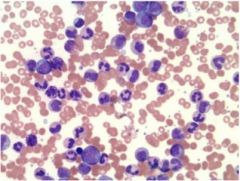![]()
![]()
![]()
Use LEFT and RIGHT arrow keys to navigate between flashcards;
Use UP and DOWN arrow keys to flip the card;
H to show hint;
A reads text to speech;
19 Cards in this Set
- Front
- Back
|
What is the hallmark of a chronic leukemia?
|
Proliferation of a neoplastic clone that exhibits partial maturation into recognizable myeloid cells or lymphocytes.
|
|
|
What are the two most common chronic leukemias?
|
1) Chronic Myelogenous Leukemia
2) Chronic Lymphocytic Leukemia |
|
|
Of what cluster of diseases is CML a member?
|
The Myeloproliferative Disorders (P Vera, Essential Thrombocythemia, Primary Myelofibrosis)
|
|
|
What are the common features of the Myeloproliferative Disorders?
|
1) Origin in a pluripotent stem cell
2) Clonal nature of disease 3) Normal maturation of cells in early stages of disease 4) Elevation of one or more blood counts 5) Capacity to transform into CML |
|
|
What is the susceptible population for CML?
|
Age >40, equal between sexes. Approx. 20% of adult leukemia is CML
|
|
|
What are the presenting symptoms of CML?
|
Often asymptomatic. Fatigue, weight loss, fevers and sweats are possible.
|
|
|
What is the hallmark of CML?
|
Leukocytosis is the hallmark of CML, with blood counts from 25K to 300K
|
|
|
What are predominant cell types in CML?
|
Mature PMNs and Bands, with excess eosinophils, basophils and platelets also common.
|
|
|
What do peripheral blast cells indicate in CML?
|
Blast cells in CML indicate an advancing disease, eventually appearing like acute leukemia with >20% blasts
|
|
|
How does the marrow present in CML?
|
Hypercellular with GRANULOCYTE precursors and mild fibrosis
|
|

Name the disease.
|
Chronic Myelogenous Leukemia
|
|
|
What tissues are commonly involved in CML?
|
Splenomegaly is common in CML, and may cause an increase in girth or early satiety.
|
|
|
What is the characteristic molecular abnormality in CML?
|
A Philadelphia translocation, t(9:22), forming the bcr-abl oncogene.
|
|
|
What are some of the complications with classifying CML?
|
1) Differentiation from P Veray or ET
2) Sometimes confused with a normal, physiologic Leukemoid Reaction following infection |
|
|
What is a Leukemoid Reaction?
|
A physiologic leukocytosis in response to stress or infection.
|
|
|
What test may be used to differentiate CML from a Leukemoid Reaction?
|
Leukocyte Alkaline Phosphatase Test
* LAP score is INCREASED in Leukemoid * LAP score is VERY LOW in CML |
|
|
What are the three phases of CML progression?
|
1) Stabe/Chronic Phase - commonly asymptomatic
2) Accelerated Phase - beginnings of left shift. Symptomatic. 3) Blast Crisis - similar to acute leukemia. Terminal stage. |
|
|
What new drug works wonders with CML in the chronic phase?
|
Imatinib, a monclonal antibody inhibitor of the ABL Tyrosine Kinase enzyme.
|
|
|
How are CML blast crisis patients treated?
|
Typically with transplant.
|

